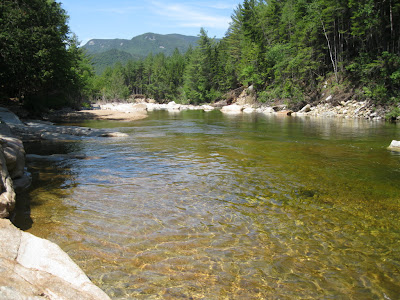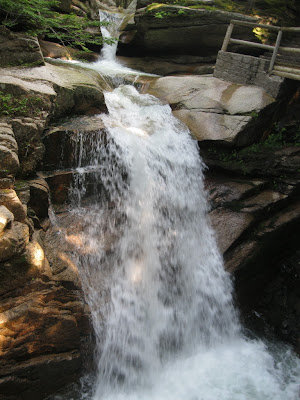WEST SLEEPER SLIDE - WITNESSING THE POWER OF TROPICAL STORM IRENE: 6/11/12
I first glimpsed the surprising new slide on the NE side of West Sleeper from a distant viewpoint on Table Mountain back in late April. A bit of research determined that it most likely fell during Tropical Storm Irene on August 28, 2011 - one of only a few slides that occurred in the Whites during that amazing burst of rainfall.
Last week I climbed Potash Mountain for a closer look at the slide, which fell into the big side valley between the Sleepers, off the main valley of Sabbaday Brook. A few winters ago Cath Goodwin and I snowshoed up this side valley to the col between the Sleepers, and found mostly open woods after an initial tangle of hobblebush. Sabbaday is one of my favorite valleys to walk in the Whites, so on my next free day I headed in to have a look at the new slide.
Mine was the only car in the lot as I set off on the Sabbaday Brook Trail in the morning.
The first 0.3 mi. of the trail, up to the side loop to Sabbaday Falls, is graded gravel. I decided to skip the falls on the way in, and visit them on the way out.
Beyond the falls, at a place where the trail splits around a loop brookbed, Irene had done some damage.
The water's been fairly high of late, but the three big crossings of Sabbaday Brook weren't difficult, I only had to use an occasional underwater rock. This the first crossing.
The second crossing is wide and shallow.
All along the trail there was evidence of excellent drainage cleaning by trail adopter Scott Wood.
The trail enters the Sandwich Range Wilderness shortly after it turns right onto an old logging road on the east side of the brook, which is followed for 1.5 mi. This sign was in the wrong location for a few years and was recently moved 0.2 mi. to the north.
A look upstream along Sabbaday Brook.
Much of this section of Sabbaday Brook Trail provides mellow, pleasant walking.
More of the same. Love this trail.
Shortly before the 4th crossing of Sabbaday Brook, I poked around the site of the old Monahan logging camp, part of the Swift River Railroad operation (1906-1916). There was never a railroad spur up Sabbaday Brook, only tote roads. From this old hanging bucket, I followed a trace of a tote road away from the camp area, hoping it would lead across to the valley I wanted to bushwhack up (Cath and I had followed an old road partway up on our snowshoe bushwhack). But it veered off into a different ravine and I ended up bushwhacking across the slope.
The bushwhack up the valley was mostly through a sea of hobblebush. It was much easier in winter. Up to this point it had been a mostly bug-free day, but now the circling squadrons of black flies were on the attack.
I saw daylight over by the brook, but knew I couldn't yet be at the slide. A closer look revealed a swath of destruction along the brook, a tangle of trees torn and ripped and carried away by the slide. As it turned out, this was 0.2 mi. downstream from the base of the slide.
In another 0.1 mi. I dropped down to the brookbed at a point where it became mostly rocky rubble. Downstream was a heaping helping of "slide salad."
The rubble along the brookbed provided much easier going than the hobblebush-infested woods, and made for an exciting approach to the slide.
Nearing the slide, part of the western slope of East Sleeper could be seen ahead.
After scrambling over some debris, I arrived at the base of the slide, where it made a 90-degree turn down the brookbed. Imagine the roar this must have made as the huge mass of debris came crashing down. It reminds me of this passage from the book, "Chocorua's Tenants" (1895), by Frank Bolles, the naturalist-writer whose favorite haunt was the Sandwich Range. Here he describes the great Downes Brook slide on Mt. Passaconaway, which fell more than a century ago one valley to the east:
"Ah, what sound is that of rending.
Crushing, crashing, splintering timber?
Hear the groans of breaking spruce trunks,
Hear the moans of straining fibres,
Hear the roar of falling boulders
Bounding down the endless ledges.
All of Passaconaway's bulwarks
Seem to break: before the storming."
When I looked up at the slide, I was stunned by how wide and massive it was. The oblique view I had from Potash didn't reveal the full extent. Wow!
I scrambled up to a shelf above the brookbed. If anything, the slide looked even more impressive from here. It fanned out in a hurry over a fairly short distance.
I clambered steeply up the packed gravel and rock for some views. From the lower part, I could see (L to R) Mt. Tremont and Owl Cliff, Carter Dome and Rainbow Ridge, Bartlett Haystack, the Baldfaces, Potash Mountain, and "South Potash."
Higher up, I could see part of Bear Mountain between Potash and South Potash, and to the R of South Potash were Big Attitash Mountain, Table Mountain and Kearsarge North. Even managed to get a boot shot in on the slide.
A closer look at the Potash peaks.
Looking across the slide. Despite the swarms of black flies, I managed to spend about an hour and a half here. An amazing place.
Mostly tall hobblebush on the return whack as well, with an occasional open stretch such as this.
The brook that drains the slide and the valley between the Sleepers, near where it joins Sabbaday Brook.
A pretty meadowy spot on Sabbaday Brook Trail above the 4th crossing.
A sled runner beside the trail near the old Monahan logging camp.
Heading back down the Sabbaday valley, you get a few tiny glimpses of the Fool Killer looming to the west. It's much more prominent with the leaves down.
Nice spot for a break along the brook.
It's a lousy photo, but Sabbaday Falls was in good flow.
Basalt dike in granite ledge below the falls.
Pothole below the falls, an interesting feature to cap off a memorable day in the Sabbaday Brook valley.

















































































